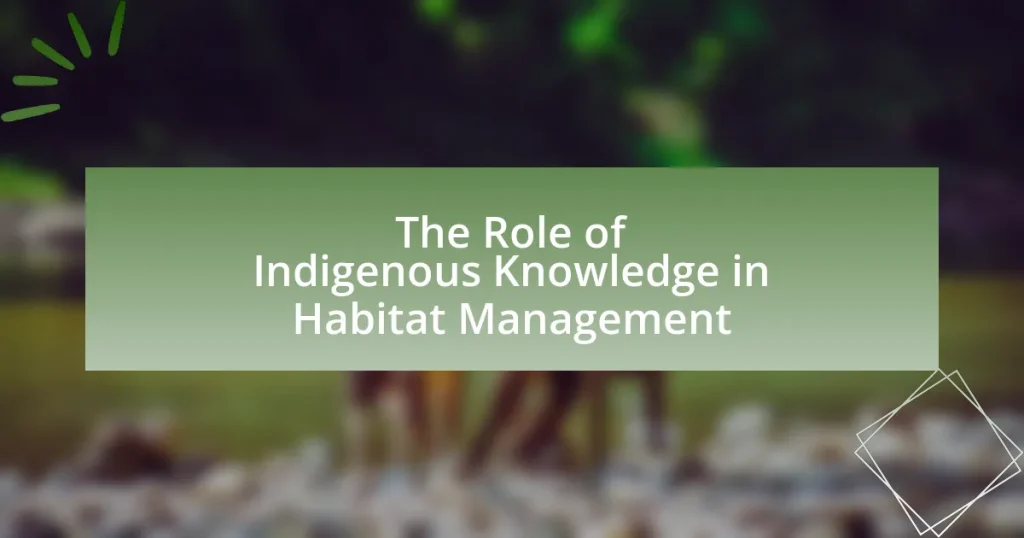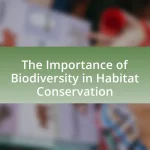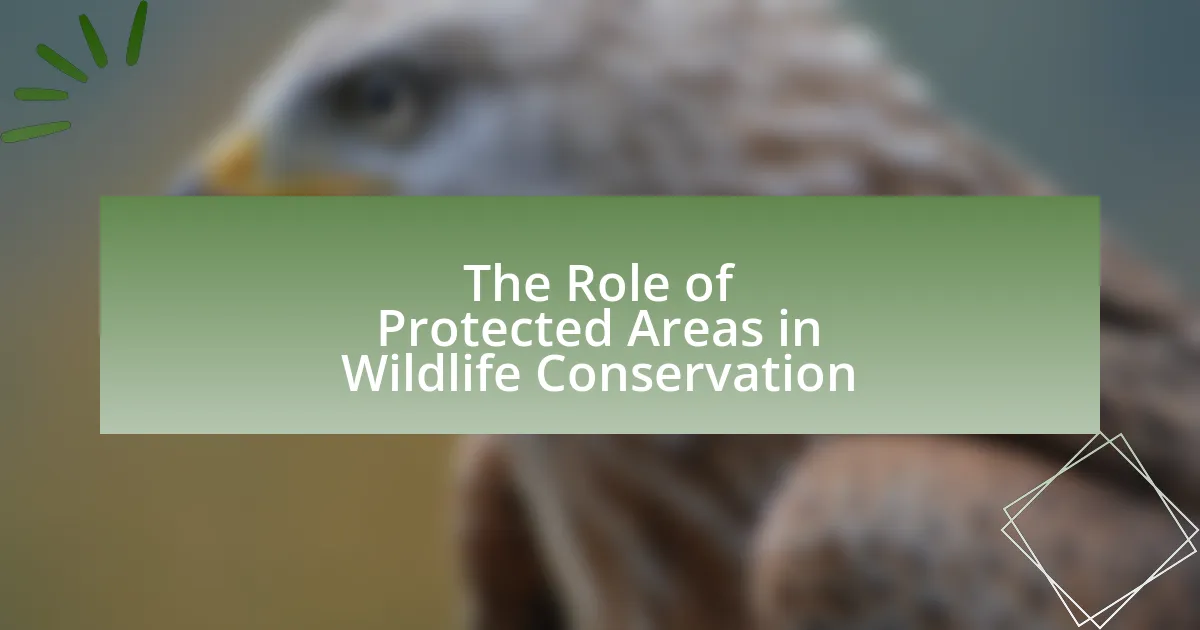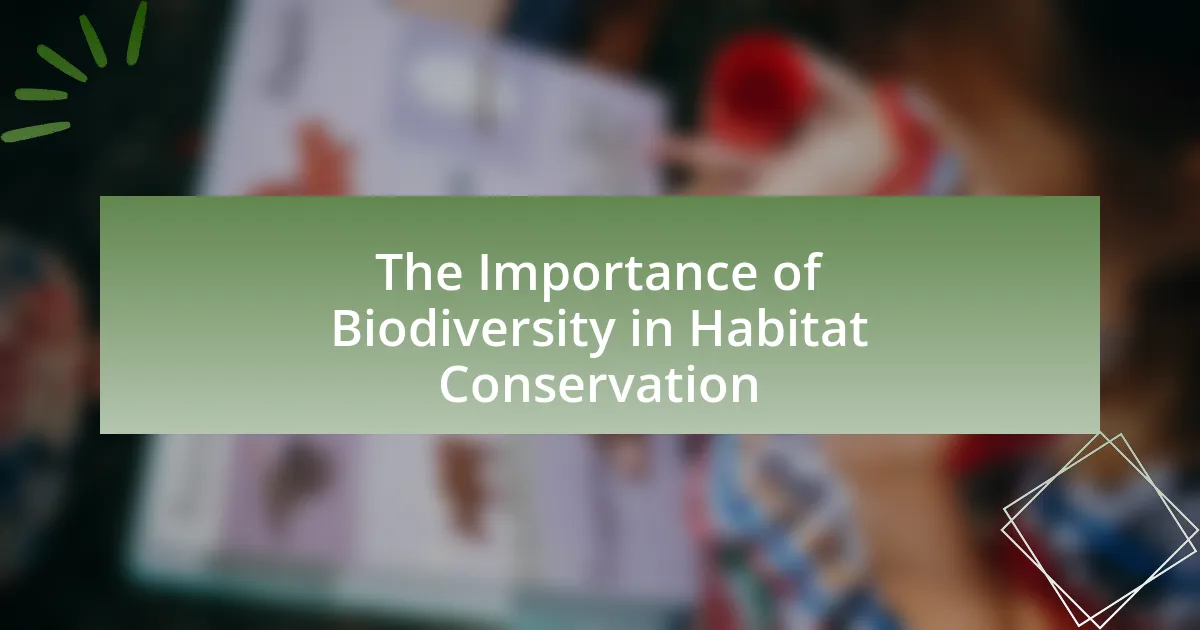The article examines the critical role of Indigenous Knowledge in habitat management, emphasizing its contributions to sustainable practices developed over generations. It highlights how traditional ecological understanding, such as controlled burns and seasonal harvesting, enhances biodiversity and ecosystem resilience, particularly in the face of climate change. The article also discusses the challenges Indigenous Knowledge faces, including institutional resistance and the undervaluation of traditional practices, while advocating for the integration of Indigenous perspectives into contemporary environmental policies and management strategies. Key principles of Indigenous Knowledge, its differences from scientific approaches, and successful examples of its application in biodiversity conservation are also explored.

What is the Role of Indigenous Knowledge in Habitat Management?
Indigenous knowledge plays a crucial role in habitat management by providing insights into sustainable practices that have been developed over generations. This knowledge encompasses traditional ecological understanding, which includes species behavior, seasonal changes, and ecosystem interdependencies. For example, Indigenous communities often utilize controlled burns to manage landscapes, a practice that has been shown to enhance biodiversity and reduce the risk of larger wildfires. Research indicates that areas managed with Indigenous practices can exhibit greater resilience to climate change, as evidenced by studies highlighting the effectiveness of traditional land stewardship in maintaining ecological balance.
How does Indigenous Knowledge contribute to effective habitat management?
Indigenous Knowledge contributes to effective habitat management by integrating traditional ecological practices with contemporary conservation strategies. This knowledge encompasses a deep understanding of local ecosystems, species behavior, and sustainable resource use, which has been developed over generations. For instance, Indigenous communities often employ controlled burns to manage landscapes, a practice that has been shown to enhance biodiversity and reduce the risk of larger wildfires, as evidenced by studies highlighting the ecological benefits of fire management in various regions. Additionally, Indigenous Knowledge emphasizes the importance of cultural connections to land, fostering stewardship and sustainable practices that align with ecological health. This holistic approach not only preserves biodiversity but also supports the resilience of ecosystems in the face of climate change.
What are the key principles of Indigenous Knowledge in environmental stewardship?
The key principles of Indigenous Knowledge in environmental stewardship include a deep connection to the land, holistic understanding of ecosystems, and the importance of traditional practices. Indigenous communities view the land as a living entity, fostering a relationship that emphasizes respect and reciprocity. This perspective leads to sustainable practices that have been honed over generations, such as controlled burns and seasonal harvesting, which maintain biodiversity and ecosystem health. Research shows that Indigenous land management practices can enhance resilience against climate change, as evidenced by studies indicating that areas managed by Indigenous peoples often exhibit greater biodiversity and ecological stability compared to those managed through conventional methods.
How does Indigenous Knowledge differ from scientific approaches to habitat management?
Indigenous Knowledge differs from scientific approaches to habitat management primarily in its holistic and experiential nature. Indigenous Knowledge encompasses a deep understanding of local ecosystems, developed over generations through direct interaction with the land, while scientific approaches often rely on empirical data and controlled experiments to inform management practices. For instance, Indigenous communities may utilize traditional ecological knowledge to manage resources sustainably, emphasizing relationships and cultural significance, whereas scientific methods typically focus on quantifiable metrics and standardized methodologies. This distinction highlights the complementary roles both knowledge systems can play in effective habitat management.
Why is Indigenous Knowledge important for biodiversity conservation?
Indigenous Knowledge is crucial for biodiversity conservation because it encompasses traditional ecological knowledge that has been developed over generations, allowing Indigenous communities to manage ecosystems sustainably. This knowledge includes understanding species interactions, seasonal changes, and land management practices that promote biodiversity. For instance, Indigenous fire management techniques have been shown to enhance habitat diversity and reduce the risk of catastrophic wildfires, as evidenced by studies in Australia where traditional burning practices have led to healthier ecosystems. Furthermore, Indigenous Knowledge often emphasizes the spiritual and cultural significance of biodiversity, fostering a deep-rooted commitment to conservation efforts.
What specific examples illustrate the success of Indigenous Knowledge in preserving ecosystems?
Indigenous Knowledge has successfully preserved ecosystems through practices such as controlled burning and sustainable fishing techniques. For instance, the use of fire by Indigenous Australians has been shown to reduce the risk of large-scale wildfires while promoting biodiversity. Research indicates that these fire management practices have maintained healthy landscapes for thousands of years, as documented in the study “Cultural Burning: A Key to Biodiversity” by the Australian Institute of Aboriginal and Torres Strait Islander Studies. Additionally, the traditional fishing practices of Indigenous communities in the Pacific Northwest, which include seasonal fishing and the protection of spawning habitats, have led to the recovery of salmon populations, as evidenced by the work of the Pacific Salmon Commission. These examples demonstrate the effectiveness of Indigenous Knowledge in ecosystem preservation.
How does Indigenous Knowledge enhance resilience to climate change in habitats?
Indigenous Knowledge enhances resilience to climate change in habitats by integrating traditional ecological practices with contemporary environmental management strategies. This knowledge, developed over generations, includes an understanding of local ecosystems, species interactions, and sustainable resource use, which can inform adaptive management practices. For instance, Indigenous communities often utilize controlled burns to manage landscapes, promoting biodiversity and reducing the risk of catastrophic wildfires, as evidenced by practices documented in the Australian Aboriginal land management systems. Furthermore, Indigenous Knowledge systems emphasize the importance of biodiversity and ecosystem health, which are critical for maintaining resilience against climate impacts, such as altered precipitation patterns and temperature fluctuations. Studies, such as those by Berkes and Folke (1998), highlight that Indigenous practices contribute to ecosystem stability, thereby enhancing the capacity of habitats to withstand climate change.
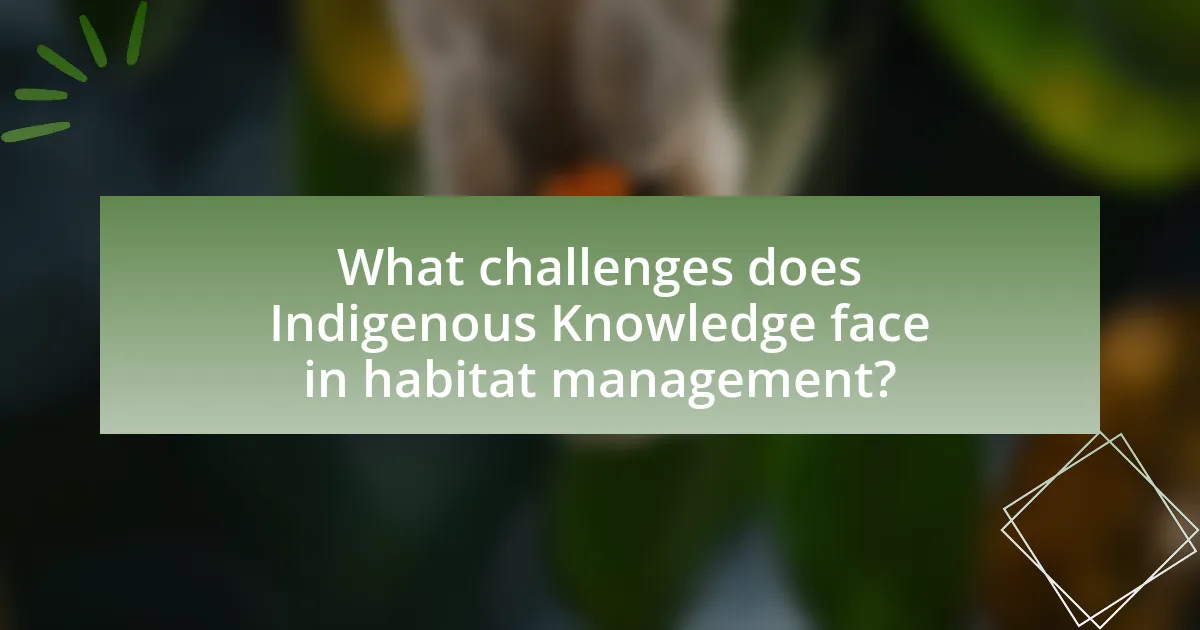
What challenges does Indigenous Knowledge face in habitat management?
Indigenous Knowledge faces several challenges in habitat management, primarily due to the lack of recognition and integration within formal environmental governance frameworks. This marginalization often leads to the undervaluation of traditional ecological practices, which are crucial for sustainable habitat management. For instance, many Indigenous communities possess extensive knowledge about local ecosystems, yet their input is frequently overlooked in policy-making processes, resulting in ineffective management strategies that do not account for local biodiversity and cultural significance. Additionally, external pressures such as climate change, land development, and resource extraction further threaten the application of Indigenous Knowledge, as these factors disrupt traditional practices and access to ancestral lands.
How do modern practices conflict with Indigenous Knowledge systems?
Modern practices often conflict with Indigenous Knowledge systems by prioritizing industrial and technological approaches over traditional ecological wisdom. For instance, contemporary land management techniques frequently disregard the holistic understanding of ecosystems that Indigenous peoples have developed over generations, which emphasizes the interconnectedness of species and their habitats. This disconnection can lead to practices such as monoculture farming and resource extraction that degrade biodiversity and disrupt local ecosystems, contrary to Indigenous practices that promote sustainability and biodiversity conservation. Studies have shown that Indigenous land management techniques, such as controlled burns, can enhance ecosystem resilience, yet these methods are often overlooked in favor of modern practices that may not consider long-term ecological impacts.
What are the barriers to integrating Indigenous Knowledge into mainstream habitat management?
Barriers to integrating Indigenous Knowledge into mainstream habitat management include institutional resistance, lack of recognition, and differing worldviews. Institutional resistance often stems from bureaucratic structures that prioritize scientific methods over traditional practices, limiting collaboration. Lack of recognition occurs when Indigenous Knowledge is undervalued or dismissed, despite its historical relevance and effectiveness in sustainable practices. Additionally, differing worldviews between Indigenous communities and mainstream scientific approaches can create misunderstandings and hinder effective communication, making it challenging to incorporate Indigenous perspectives into habitat management strategies.
How can these challenges be addressed to promote collaboration?
To address challenges in promoting collaboration in habitat management, integrating Indigenous knowledge into decision-making processes is essential. This integration fosters mutual respect and understanding between Indigenous communities and other stakeholders, leading to more effective management strategies. Research indicates that collaborative frameworks that include Indigenous perspectives enhance biodiversity conservation and ecosystem resilience, as demonstrated in studies like “Indigenous Knowledge and Biodiversity Conservation” by Berkes (2012), which highlights successful case studies where Indigenous practices improved habitat management outcomes. By recognizing and valuing Indigenous knowledge, stakeholders can create inclusive platforms that facilitate dialogue, share resources, and develop joint initiatives, ultimately strengthening collaborative efforts in habitat management.
What role do Indigenous communities play in habitat management today?
Indigenous communities play a crucial role in habitat management today by utilizing traditional ecological knowledge to sustainably manage natural resources. This knowledge, developed over generations, includes practices such as controlled burns, seasonal harvesting, and biodiversity conservation, which enhance ecosystem resilience. For instance, studies have shown that Indigenous land management practices can lead to improved biodiversity outcomes, as evidenced by the success of Indigenous-led initiatives in Australia, where traditional fire management has reduced the risk of catastrophic wildfires and promoted the health of native species.
How are Indigenous communities advocating for their knowledge in environmental policies?
Indigenous communities are advocating for their knowledge in environmental policies by actively participating in decision-making processes and collaborating with governmental and non-governmental organizations. These communities leverage traditional ecological knowledge, which encompasses sustainable practices honed over generations, to influence policies that affect their lands and resources. For instance, the United Nations Declaration on the Rights of Indigenous Peoples emphasizes the importance of Indigenous participation in environmental governance, recognizing their unique relationship with the environment. Additionally, case studies, such as the involvement of Indigenous groups in the management of the Great Bear Rainforest in Canada, demonstrate how their insights lead to more effective conservation strategies. This advocacy not only empowers Indigenous voices but also enhances the overall effectiveness of environmental policies by integrating diverse knowledge systems.
What partnerships exist between Indigenous communities and conservation organizations?
Partnerships between Indigenous communities and conservation organizations often focus on collaborative management of natural resources, integrating traditional ecological knowledge with scientific approaches. For example, the Indigenous-led organization, the Indigenous Environmental Network, collaborates with various conservation groups to protect sacred lands and promote sustainable practices. Additionally, the partnership between the Haida Nation and the Nature Conservancy has led to successful marine conservation efforts in British Columbia, demonstrating the effectiveness of combining Indigenous stewardship with conservation strategies. These partnerships are supported by evidence showing that areas managed by Indigenous peoples often have higher biodiversity and better ecological health, as highlighted in studies published by the United Nations and various environmental journals.
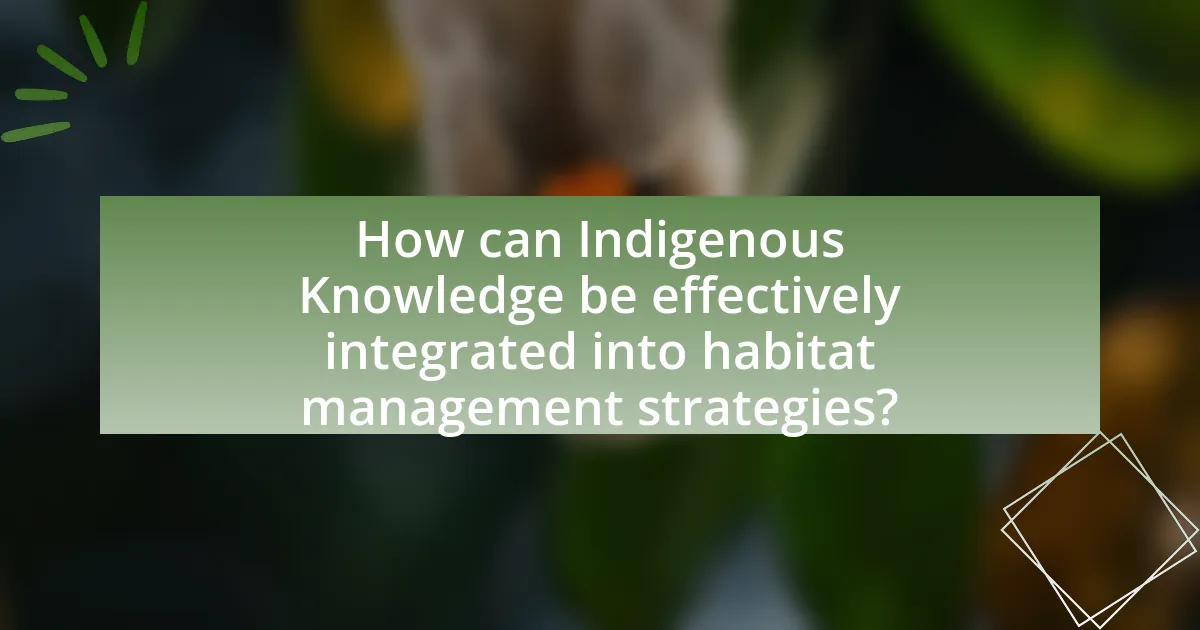
How can Indigenous Knowledge be effectively integrated into habitat management strategies?
Indigenous Knowledge can be effectively integrated into habitat management strategies by incorporating traditional ecological practices and community engagement in decision-making processes. This integration allows for the utilization of local knowledge regarding species behavior, ecosystem dynamics, and sustainable resource use, which has been developed over generations. For instance, studies have shown that Indigenous fire management techniques can reduce wildfire risks and promote biodiversity, as evidenced by the successful application of these methods in Australia, where Indigenous land management practices have led to healthier ecosystems and improved land resilience. By recognizing and valuing Indigenous perspectives, habitat management strategies can become more holistic and effective, ultimately leading to better environmental outcomes.
What best practices should be followed for incorporating Indigenous Knowledge?
To effectively incorporate Indigenous Knowledge, it is essential to engage with Indigenous communities through respectful collaboration and active participation. This approach ensures that the knowledge shared is authentic and contextually relevant. Research indicates that Indigenous Knowledge systems are deeply rooted in local ecosystems and cultural practices, making them invaluable for habitat management (Berkes, 2012). Furthermore, establishing long-term partnerships with Indigenous peoples fosters trust and mutual understanding, which enhances the integration of their knowledge into contemporary environmental practices.
How can stakeholders ensure respect for Indigenous Knowledge in habitat management?
Stakeholders can ensure respect for Indigenous Knowledge in habitat management by actively involving Indigenous communities in decision-making processes. This involvement includes recognizing and integrating traditional ecological knowledge, which has been developed over generations and is crucial for sustainable habitat management. For instance, studies have shown that Indigenous practices often lead to better biodiversity outcomes, as seen in the successful management of fire regimes by Indigenous Australians, which has maintained healthy ecosystems for thousands of years. By fostering partnerships, providing platforms for Indigenous voices, and ensuring equitable access to resources, stakeholders can honor and utilize Indigenous Knowledge effectively in habitat management.
What frameworks exist for collaboration between Indigenous and non-Indigenous knowledge systems?
Frameworks for collaboration between Indigenous and non-Indigenous knowledge systems include the Collaborative Management Framework, the Two-Eyed Seeing approach, and the Indigenous Knowledge and Science Partnership Model. The Collaborative Management Framework emphasizes shared decision-making and co-management of resources, allowing both knowledge systems to inform practices. The Two-Eyed Seeing approach, developed by Mi’kmaq elder Albert Marshall, integrates Indigenous and Western scientific perspectives, promoting mutual respect and understanding. The Indigenous Knowledge and Science Partnership Model fosters partnerships that leverage both Indigenous knowledge and scientific research to address environmental challenges. These frameworks have been validated through various case studies demonstrating successful integration of knowledge systems in habitat management, such as the work done in the Great Bear Rainforest in British Columbia, where Indigenous stewardship practices were combined with scientific research to enhance biodiversity conservation.
What practical steps can be taken to support Indigenous Knowledge in habitat management?
To support Indigenous Knowledge in habitat management, practical steps include integrating Indigenous perspectives into policy-making and management practices. This can be achieved by establishing collaborative partnerships between Indigenous communities and environmental agencies, ensuring that Indigenous voices are included in decision-making processes. For instance, the United Nations Declaration on the Rights of Indigenous Peoples emphasizes the importance of respecting Indigenous knowledge systems in environmental governance. Additionally, training programs that educate non-Indigenous managers about Indigenous practices can enhance mutual understanding and respect. Research shows that areas managed with Indigenous knowledge often exhibit greater biodiversity and resilience, highlighting the effectiveness of these practices in habitat management.
How can education and awareness programs promote the value of Indigenous Knowledge?
Education and awareness programs can promote the value of Indigenous Knowledge by integrating traditional ecological practices into formal curricula and community outreach initiatives. These programs can highlight the sustainable practices and biodiversity conservation methods that Indigenous communities have utilized for centuries, thereby demonstrating their relevance in contemporary habitat management. For instance, research shows that Indigenous land management techniques, such as controlled burns, have been effective in reducing wildfire risks and enhancing ecosystem health. By educating the public and policymakers about these practices, awareness programs can foster respect for Indigenous Knowledge and encourage its application in modern environmental strategies.
What role does policy reform play in enhancing the role of Indigenous Knowledge in habitat management?
Policy reform plays a crucial role in enhancing the role of Indigenous Knowledge in habitat management by creating frameworks that recognize and integrate traditional practices into environmental governance. Such reforms can lead to the establishment of co-management agreements, which empower Indigenous communities to participate actively in decision-making processes regarding land and resource management. For instance, the United Nations Declaration on the Rights of Indigenous Peoples emphasizes the importance of Indigenous participation in environmental stewardship, thereby legitimizing their knowledge systems. This integration has been shown to improve biodiversity outcomes, as Indigenous practices often promote sustainable land use and conservation strategies that have been refined over generations.
